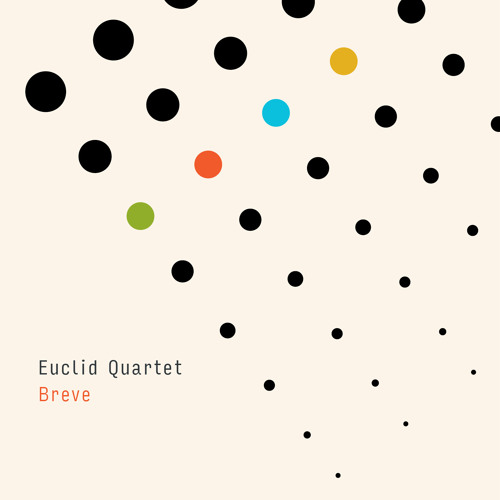Breve (11 short selections for string quartet by 11, 18-20th C. composers); Euclid Quartet [Afinat Records]
This album offers something a little different, namely some outstanding, short pieces for string quartet that are frequently performed as encores. More specifically, these selections played here by the Euclid Quartet (
EQ) are each by a different 18-20th century composer.
It starts with Austrian composer Wolfgang Amadeus Mozart's (
1756-1791)
Adagio and Fugue in C minor (
K.546; 1788) [T-1, 7'10"]. This has an ominous "
Adagio (Slow)" opening [00:00], but the subsequent "
Fugue" [02:59] brings the piece to a more sanguine conclusion.
Next we get Mexican composer Javier Álvarez's (
1956-2023)
Metro Chabacano (
1991) [T-2, 3'57"], which was inspired by an eponymous
metro station located in
Mexico City. It has a skittish opening [00:00], which persists throughout this busy piece.
After that, we're off to Italy and Giacomo Puccini's (
1858-1924)
Crisantemi (Chrysanthemums) of
1890 [T-3, 6'18"]. This has outer sections [00:00, 03:50] featuring a lovely theme. These surround a songful segment [02:03-03:49] and end the piece much like it started.
Then it's back to Austria with a hint of Italy for Hugo Wolf's (
1860-1903)
Italian Serenade (
1887) [T-4, 6'59"]. This has an opening, whimsical theme [00:00] that undergoes a delightful exploration, which brings the piece to a blithe conclusion.
Subsequently, we cross the
Atlantic for the United States and William Bolcom's (b.
1938)
Graceful Ghost Rag (
1970) [T-5, 4'20"]. You'll find it's a real winner that may remind you of those Scott Joplin (
1868-1917) wrote for the
piano.
After that we get a real change of pace as the
EQ serves up a Russian
zakuska. It's Dimitri Shostakovich's (
1906-1975) Polka (
1931) [T-6, 2'45"], which is an arrangement of the one from the Music Hall scene in his ballet
The Golden Age (
Op. 22; 1930). This finds the composer at his most whimsical.
Next, it's back to America for George Gershwin's (
1898-1937)
Lullaby for String Quartet (
1919) [T-7, 8'12"]. This was a student work, and the first of its two sections has a mellow opening [00:00] soon followed by a lovely,
berceuse melody (LB) [00:19]. Then LB undergoes a gentle development [01:47], but after a brief pause, it's food for a more pronounced, "
con fuoco (with fire)" marked segment [06:03]. However, this wanes thereby ending the piece tranquilly.
Then we visit Austria again for the next two selections, the initial one being Franz Schubert's (
1797-1828)
Quartettsatz (Quartet Movement) in C minor (
D 703; 1820) [T-8, 8'54"]. Apparently, this began what would have been his 12th quartet had he finished it.
More specifically, it's marked "
Allegro assai (Very fast)" and in
sonata form. The
exposition has a thematic nexus with twitchy [00:00] as well as tuneful [00:30] ideas. Then the foregoing is material for a captivating
development [03:47] followed by a comely
recapitulation [06:24] with a dashing
coda [08:34] that brings things to an emphatic conclusion.
The other Austrian selection is Anton Webern's (
1883-1945)
Langsamer Satz (Slow Movement) of
1905 [T-9, 8'50"]. It's an early work that was seemingly inspired by his love for a woman he later married. And like the Schubert (see above), this was apparently the only part Anton completed of what was to be a full quartet.
It's marked "
Langsam, mit bewegtem Ausdruck (Slow, with moving expression)", and takes the form of a heartfelt serenade based on an extended, amorous, opening thought [00:00]. After that there's a brief pause [04:43] followed by pensive passages [04:45] and another a short break [05:41]. Then we get yearning moments [05:42] that become quite dramatic [07:00] and wane into some [07:56], which end the work peacefully.
However, the pace quickens with Argentine composer Astor Piazzolla's (
1921-1992)
Four, for Tango (
1988) [T-10, 4'51"]. Right from the start [00:00], this is a titillating, virtuosic number laced with a variety of special string effects. These include
bowing,
plucking as well as
tapping ones, and there's never a dull moment!
Last but not least, the
EQ gives us Spanish composer Joaquín Turina's (
1882-1949)
La Oración del Torero (The Toreador's Prayer). This is his
Op. 34 of 1925 [T-11, 8'05"], and was apparently inspired when he watched a bullfight at
Las Ventas in
Madrid.
It has a lively preface [00:00] hinting at a proud melody (PM) that soon follows [00:18]. Then the latter is explored, and after a brief pause [02:37], becomes the material for a pious episode [02:38]. But PM returns [04:25], invoking more prayer-like passages [05:24], followed by a gorgeous PM-derived thought [06:19] that ends the work and CD devoutly.
Nine of these selections [T-1, 3-8, 10-11] feature all four of the
EQ's regular members (first-violinist
Jameson Cooper, second-violinist
Aviva Hakanoglu, violist
Luis Enrique Vargas and cellist
Justin Goldsmith. However, Hakanagolu and Goldsmith are respectively replaced by violinist
Brendan Shea and cellist
Jacqueline Choi in the second [T-2] and ninth [T-9] ones. Be that as it may, they all deliver superb accounts of this music.
The recordings were made between February 2020 and April 2023 at
Indiana University South Bend's Louise E. Addicott and Yatish J. Joshi
Performance Hall. Despite the three-year timespan, they present uniformly, convincing sonic images of everything in a pleasant venue. The instruments are placed from left to right in order of increasing size, and the overall sound is acceptable. However, this release falls a bit short of an "Audiophile" rating, but gets a strong recommendation considering the delightful assortment of goodies present.
--
Bob McQuiston, Classical Lost and Found (CLOFO.com, P240430)








